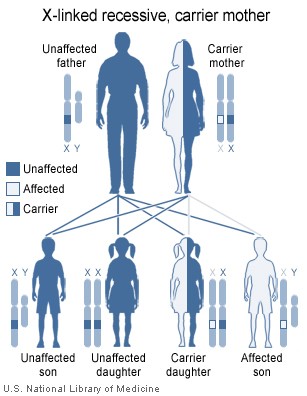Duchenne muscular dystrophy
Duchenne muscular dystrophy (DMD) (also known as pseudohypertrophic muscular dystrophy or muscular dystrophy - Duchenne type) is an inherited disorder characterized by rapidly progressive muscle weakness which starts in the legs and pelvis and later affects the whole body. Duchenne muscular dystrophy (DMD) is the most common form of muscular dystrophy. It usually affects only boys, but in rare cases it can also affect girls. It is an X-linked recessive inherited disease. A milder form of this disease is known as Becker Muscular dystrophy (BMD). In Becker muscular dystrophy, most of the symptoms are similar to Duchenne, but the onset is later and the course is milder. more...
DMD is named after the French neurologist Guillaume Benjamin Amand Duchenne (1806-1875), who first described the disease in the 1860s. One third of the cases are known to be caused by development of spontaneous mutations in the dystrophin gene, while the remainder are inherited. Boys with DMD develop weak muscles because the muscle fibers that were present at birth are destroyed. It is due to mutations in the dystrophin gene, which encodes a cell membrane protein in myocytes (muscle cells).
Onset
Symptoms usually appear in males between 1 and 6 years of age, however females, on rare occasions, can develop the disease. By age 10, braces may be required for walking, and by age 12, most children require use of a wheelchair for mobility. Bones may develop abnormally, causing skeletal deformities of the spine and other areas due to contractures (shortening of muscle tissue). Muscular weakness and skeletal deformities contribute to frequent breathing disorders. Cardiomyopathy occurs in almost all cases. Intellectual impairment occurs in approximately 30% of Duchenne's patients, but does not worsen as the disorder progresses. Duchenne muscular dystrophy occurs in approximately 1 out of 3,500 males. Because this is an inherited disorder, risks include a family history of Duchenne muscular dystrophy. A mother carrying the Duchenne gene has a 50% chance of passing the disease on to any male children.
In contrast, Becker muscular dystrophy is a form that starts later and progresses much more slowly. The key complication in BMD is cardiomyopathy, and patients must take care to monitor their cardiac health.
Genetics
Duchenne dystrophy is a type of dystrophinopathy which includes a spectrum of muscle disease caused by mutations in the DMD gene, which encodes the protein dystrophin. Becker's muscular dystrophy is a milder type of dystrophinopathy. Although it is caused by a defective gene, it often occurs in people from families without a known family history of the condition.
Duchenne muscular dystrophy is inherited in an X-linked recessive pattern. This means that women are almost never affected; women normally have two X chromosomes, one of which contains a normal, dominant copy of the gene that will make enough of the protein for them to avoid symptoms. Women who carry the defective gene can pass an abnormal X on to their sons, however. Since boys have an X from their mother and a Y from father, there is no second X to make up for the defective gene from the carrier mother. The sons of carrier females each have a 50% chance of having the disease, and the daughters each have a 50% chance of being carriers. Daughters of men with Duchenne also have a 50% chance of being carriers.
Read more at Wikipedia.org



